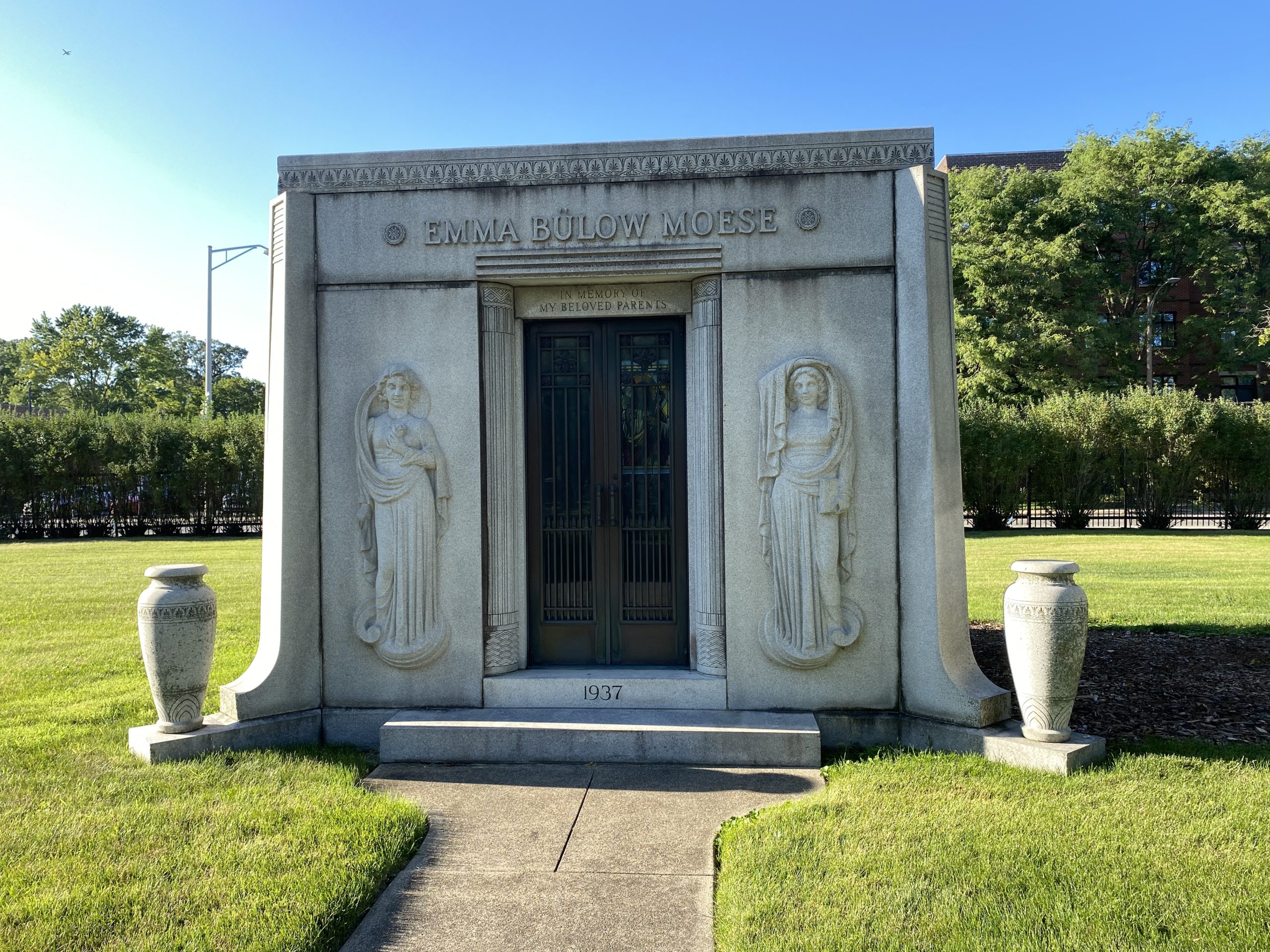Emma Bülow Moese
4 December 1885 – 3 March 1959
Richard Conrad Moese
8 June 1899 – 20 August 1977
Wilhelm Bülow
15 March 1854 – 6 February 1925
Hulda Zinke Bülow
16 August 1855 – 1 May 1934
There are only a few mausoleums at Concordia, and I’ve documented all but three of them so far. Emma Bülow Moese’s is the next one and stands across the path from William Ganschow‘s and just around the way from Dr. Selma O. Colbe‘s which is quite similar in design. Both mausoleums were erected by only daughters in honor of their parents and both these women were born around 1885. I have no idea if they knew each other but I like to think maybe they were friends.
The mausoleum appears to have been purchased after Emma’s father Wilhelm passed away. Just due to the timing, he was likely relocated from wherever his original resting place was to the mausoleum in 1932. Emma’s mother died two years later and joined her husband.
Emma was the youngest of five children (four surviving to adulthood) and the only girl. Her older brothers don’t appear to have married or had children. Brother Paul died in 1914 and was buried across the way in Section 1 where he still rests. Brother Fred died in 1933 and is buried at Ebenezer Lutheran. One wonders if there was some estrangement behind why the brothers were not included in the mausoleum which, though large enough to accommodate six, only holds four. Unlike other mausoleums of similar size, this one has two free-standing units of two crypts each rather than the more built-in style one usually sees. Another unusual aspect of this one is that the front doors have wire screens on the inside behind the glass, probably for long-term safety and maybe to keep the glass from breaking, but it makes it pretty much impossible for my little iPhone to photograph the interior as once you get close enough, the focus locks on the screen.
Emma was born in 1885 so doesn’t show up in the public records until the 1900 census and by then all the Bülow children are grown by contemporary standards, though Emma is not yet working. Wilhelm Bülow and all of his sons, however, are listed as working as peddlers on this census (which is the only one which includes the entire family).
Oldest son Charles vanishes from the public records after the 1900 census. His mother Hulda still lists four living children of five born on the 1910 census, however, so he appears to have still been alive then. An interesting bit of information on this census, however, is that Hulda has an occupation listed which is practically unheard of for a wife and mother in the time period. She was also living with her husband and two adult sons, and all of them are apparently working together running a tailor shop, a shift from the 1900s peddling. So perhaps it was a situation where all hands were needed to keep the family business running.
Emma disappears from the public records as well between 1900 and her marriage certificate in 1922. One presumes she was working and supporting herself in that interval but it’s anyone’s guess at this point as I can find nothing. What’s interesting is that Emma is almost fifteen years older than her husband. Richard worked for General Electric and beyond the evidence of the mausoleum, it seems they had a good quality of life. It’s possible that Emma had a first marriage during the mystery gap and inherited money from that; it may be that she found work in a lucrative field and was able to retire to a more traditional life with some wealth. This is just speculation as her maiden name is still the one she used on her marriage record to Richard. That isn’t decisive proof of no prior marriage but it is more usual to see the woman using her first-married name on a second marriage certificate. I’ve no idea what the laws dictating legal names were back then but it’s also possible she changed it back after a divorce. She might also have made money in some shady way (it was Jazz-Age Chicago after all). Or it could be the money was all Richard’s and he took a very “what’s mine is ours” position on its use.
This is all guessing based on the mausoleum that holds Emma and her husband and her parents having her name over the door and dedicated to her parents’ memory. This seems to indicate that Emma was the one who was financially responsible for purchasing it.
After her father died, her mother Hulda moved in with Emma and Richard, and in 1930, the census lists them all living together on Whipple Street (another victim of the construction of interstates that cut through Cook County). Hulda would pass four years later and join her husband in the mausoleum.
Emma and Richard moved out to Itasca at some point after this — most likely after the war — and lived the rest of their lives there.
RIP Emma and family
Please visit my Instagram for any questions or comments on this post!
